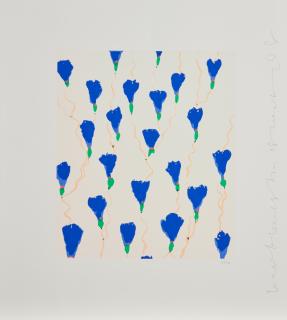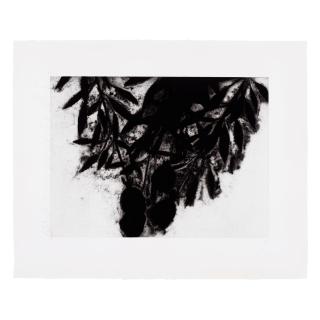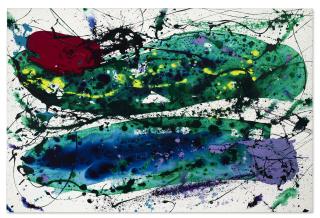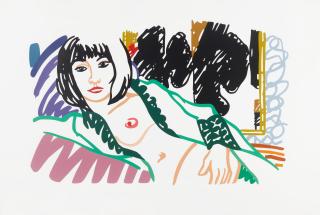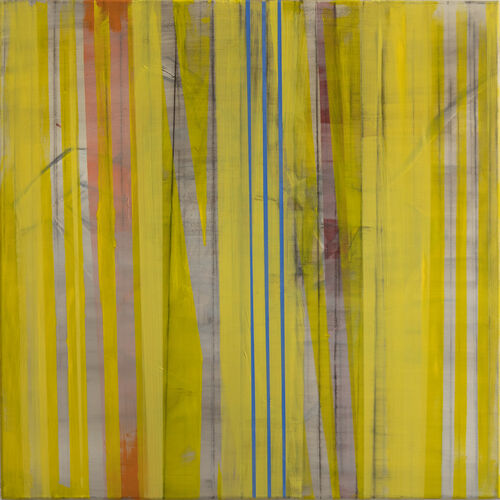Donald Sultan American, born 1951
The artist Donald Sultan
- Contemporary US artist of Pop Art and Abstract Expressionism.
- One of the first visual artists to incorporate industrial fabrics in his work.
- Known for large-scale still lifes with stylised, sharply outlined floral motifs.
Donald K. Sultan, born 05.05.1951 in Asheville, North Carolina, is a contemporary American painter, sculptor and graphic artist of Pop Art and Abstract Expressionism. Sultan is primarily known for his large-format still lifes and for his use of various industrial materials and tools. He is considered one of the first artists to use tar, putty or vinyl instead of classical colours in his paintings. The visual language of his compositions can be divided into two lines.
Some of his paintings feature bright colours with clearly defined yet stylised shapes and sharp outlines that form a distinct silhouette, for which he often uses a floral motif. In parallel, he also produces dark, hard-to-read images full of menace, often inspired by catastrophic events such as warehouse fires, plane crashes or train derailments. Sultan studied art at the University of North Carolina at Chapel Hill, graduating with a Bachelor of Fine Arts in 1973.
He then completed a Master of Fine Arts at the Art Insitute of Chicago and moved to New York shortly afterwards. His rising artistic career began with a job as a craftsman in an art gallery. He made a name for himself in the late 1970s primarily as part of the New Image movement - the first solo show of his work was held at Artists Space in New York in 1977. In 1979, Sultan finally won a $2,500 grant from the New York State Council on the Arts, enabling him to devote himself entirely to art.
From then on, he became increasingly well-known, so that in 1987 alone, some ten years later, his works were exhibited solo at the Chicago Museum of Contemporary Art, the Los Angeles Museum of Contemporary Art, the Modern Art Museum of Fort Worth, the Brooklyn Museum and the Blum Helman Gallery in New York. Sultan experienced the peak of his career in the late 1980s: Some of his paintings sold for more than $100,000 each during this period. Today, the artist still lives and works in New York.
Der Künstler Donald Sultan
- Zeitgenössischer Künstler der Pop-Art und des abstrakten Expressionismus.
- Einer der ersten bildenden Künstler, der Industriestoffe in seinen Werken verarbeitete.
- Bekannt für großformatige Stillleben mit stilisierten, scharf umrissenen floralen Motiven.
Donald K. Sultan, geb. 05.05.1951 in Asheville, North Carolina, ist ein zeitgenössischer US-amerikanischer Maler, Bildhauer und Grafiker der Pop-Art und des abstrakten Expressionismus. Bekannt ist Sultan vorrangig für seine großformatigen Stillleben sowie für die Verarbeitung verschiedener industrieller Stoffe und Werkzeuge. Er gilt als einer der ersten Künstler, die Teer, Spachtelmasse oder Vinyl anstelle von klassischen Farben in ihren Gemälden verwerteten. Die Bildsprache seiner Kompositionen lässt sich in zwei Linien aufteilen: Einige seiner Bilder zeigen leuchtende Farben mit klar definierten, aber dennoch stilisierten Formen und scharfen Umrissen, die eine deutliche Silhouette bilden und für die er sich häufig einer floralen Motivik bedient.
Parallel dazu fertigt er auch dunkle, schwer lesbare Bilder voller Bedrohung, die oft von katastrophalen Ereignissen wie Lagerhausbränden, Flugzeugabstürzen oder Zugentgleisungen inspiriert werden. Sultan absolvierte ein Kunststudium an der University of North Carolina in Chapel Hill, das er 1973 mit einem Bachelor of Fine Arts 1973 abschloss. Daraufhin absolvierte er einen Master of Fine Arts am Art Insitute of Chicago und zog kurz darauf nach New York.
Seine künstlerische Aufsteigerkarriere begann mit einer Anstellung als Handwerker in einer Kunstgalerie. Einen Namen machte er sich in den späten 1970er-Jahren vor allem als Teil der New-Image-Bewegung – die erste Einzelschau seiner Arbeit wurde 1977 im Artists Space in New York abgehalten. 1979 gewann Sultan schließlich ein 2.500-Dollar-Stipendium vom New York State Council on the Arts – so war es ihm möglich, sich gänzlich der Kunst zu widmen.
Von da an wurde er immer bekannter, sodass seine Werke allein im Jahr 1987, rund zehn Jahre später, im Chicago Museum of Contemporary Art, im Los Angeles Museum of Contemporary Art, im Modern Art Museum of Fort Worth, im Brooklyn Museum und in der Blum Helman Gallery in New York solo ausgestellt wurden. Den Höhepunkt seiner Karriere erlebte Sultan in den späten 1980er-Jahren: Einige seiner Gemälde wurden in diesem Zeitraum für mehr als 100.000 Dollar pro Stück verkauft. Heute lebt und arbeitet der Künstler noch immer in New York.
Donald Sultan in a nutshell
Without a doubt, flowers in general are among Donald Sultan's favorite motifs. However, the Pop Art artist is best known for his stylized poppies. In this way, he is very clearly aligned with the Pop Art aesthetic: The genre simplifies and relies on graphic as well as easily reproducible forms of representation. In Poppies, Sultan concentrates on traditional still-life painting on the one hand and combines it with modern techniques and materials on the other. He gives form to the flowers, which are perceived as fragile and beautiful, with the help of rough, industrial materials such as hot tar, putty, or masonite. He himself skillfully uses this to set the stage for his own artistic motto: »The best art contains paradox, whether visual or narrative.«
It's 1983 when Sultan first painted his famous lemons. In 1988, the Museum of Modern Art in New York presented the first solo exhibition on the Lemons, and Sultan's citrus fruits spread like wildfire. The now well-known painting Black Lemons (1985) plays with the negative space of the fruits, which otherwise tend to be the focus of attention because of their gaudy color. At the same time, the fruits develop a life of their own, giving the impression of growing beyond the limits of their medium. Like his Poppies, the Lemons have an effect with their banality and a depth that charcoal, for instance, elicits from the Black Lemons. The plain lemons once again rely on reproducibility. The representations in black color in particular have an inherent effect of surprise, through which a threatening presence enters the picture.
Donald Sultan's mimosa plants find their origin in a gift from a friend in the south of France. Sultan repeats his familiar technique in his depictions of the fine-leafed plant: there is room for both negative space and industrial materials, such as roofing felt, vinyl, tar, masonite, or enamel, which give the organic still life its modern polish. Many of the Mimosa paintings date from the 2010s and 2020s.
Donald Sultan's floral motifs span his entire oeuvre, so it's not surprising that among his best-known paintings are those featuring flowers or fruit, which often resemble other works. Among the most prominent are probably Red Poppies (2003), Lemons (1984), Apples and Oranges (1987), Fifteen Oranges (1992) or Black Eggs (1988).
Häufige Fragen zu Donald Sultan
Zweifelsohne zählen Blumen im Generellen zu Donald Sultans Lieblingsmotiven. Am bekanntesten ist der Pop-Art-Künstler allerdings für seine stilisierten Mohnblumen (engl. Poppies). Er schließt sich damit sehr deutlich der Pop-Art-Ästhetik an: Die Stilrichtung vereinfacht und setzt auf grafische wie leicht zu reproduzierende Darstellungsformen. Bei den Mohnblumen konzentriert sich Sultan auf der einen Seit auf tradierte Stilllebenmalerei und kombiniert sie auf der anderen Seite mit modernen Techniken und Materialien. Den als zerbrechlich und schön wahrgenommenen Blumen verleiht er mithilfe von rauen, industriellen Materialien wie heißem Teer, Spachtelmasse oder Masonit eine Form. Er selbst setzt seinen eigenen künstlerischen Leitsatz damit gekonnt in Szene: »Die beste Kunst enthält Paradoxien, ob visuell oder erzählerisch.«
Es ist 1983 als Sultan das erste Mal seine berühmten Zitronen malte. Als das Museum of Modern Art in New York 1988 das erste Mal eine Einzelausstellung zu den Lemons präsentiert, verbreiten sich Sultans Zitrusfrüchte wie ein Lauffeuer. Das heute bekannte Bild Black Lemons (1985) spielt mit dem Negativraum der Früchte, die sonst eher wegen ihrer knalligen Farbe im Fokus stehen. Gleichzeitig entwickeln die Früchte ein Eigenleben, erwecken den Eindruck, über die Grenzen ihres Mediums hinauszuwachsen. Wie seine Poppies wirken auch die Lemons mit ihrer Banalität und einer Tiefe, die etwa die Holzkohle den Black Lemons entlockt. Die schlichten Lemons beruhen wieder einmal auf Reproduzierbarkeit. Gerade den Darstellungen in schwarzer Farbe wohnt ein Überraschungseffekt inne, der eine bedrohliche Präsenz ins Bild einkehren lässt
Die Mimosenpflanzen (Mimosas) von Donald Sultan finden ihren Ursprung im Geschenk eines Freundes aus Südfrankreich. Sultan wiederholt seine bekannte Technik bei den Darstellungen der feinblättrigen Pflanze: Sowohl der Negativraum findet Platz als auch industrielle Materialien, wie etwa Dachpappe, Vinyl, Teer, Masonit oder Emaille, die dem organischen Stillleben seinen modernen Schliff verpassen. Viele der Mimosa-Gemälde stammen aus den 2010ern und 2020ern.
Donald Sultans florale Motive erstrecken sich über sein gesamtes Oevre, sodass es nicht verwundert, dass sich unter seinen bekanntesten Bildern solche mit Blumen oder Obst befinden, die anderen Werken häufig ähneln. Zu den prominentesten gehören wohl Red Poppies (2003), Lemons (1984), Apples and Oranges (1987), Fifteen Oranges (1992) oder Black Eggs (1988).

